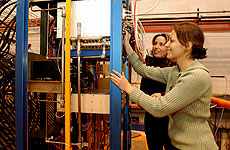Neutrino work at Fermilab gets EPS award

Niki Saoulidou (front) and Simona Murgia help assemble the MINOS near detector in 2004 at the New Muon Laboratory.
Niki Saoulidou is drawn to mysteries, the chance to sort through clues and piece together an answer.
Neutrinos, which have been involved in many mysteries and "anomalies" during the past 80 years, were ideal particles for her to study.
"Neutrinos have shown, so far, perhaps the only hints of physics beyond the Standard Model," she said. "No one expected how they behave a few years ago, and the hope is that they will continue to surprise us in the years to come."
Saoulidou, 34, born and raised in Athens, Greece, has immersed herself in neutrino research from detector construction to analysis. She has participated in Fermilab neutrino experiments since her graduate school days at the University of Athens. She received her Ph.D. from that university in 2003.
That breadth and depth of her experience coupled with a passion for her work, which materializes in animated gestures and twinkling eyes when she talks about research, likely captured the attention of the European Physical Society. They picked her as one of two winners of the high-energy particle physics 2009 Young Physicists Prize. She will receive the award for outstanding neutrino research today at the EPS conference in Krakow.
The small size of neutrino collaborations often allows young physicists to work on varied aspects of research, rather than specialize early in their careers.
Saoulidou got to work on hardware, software and data analysis for the DONUT (E872) and MINOS (E875) experiments. As a member of NOvA (E929) and a future wide-band beam neutrino experiment from Fermilab to the proposed Deep Underground Science and Engineering Laboratory she also worked on software, simulation and optimization studies.
"I think Niki was one of the most productive members of the MINOS collaboration, both in putting the hardware together in the Near Detector and in the analysis," said Stan Wojcicki, MINOS spokesman.
-- Tona Kunz
|